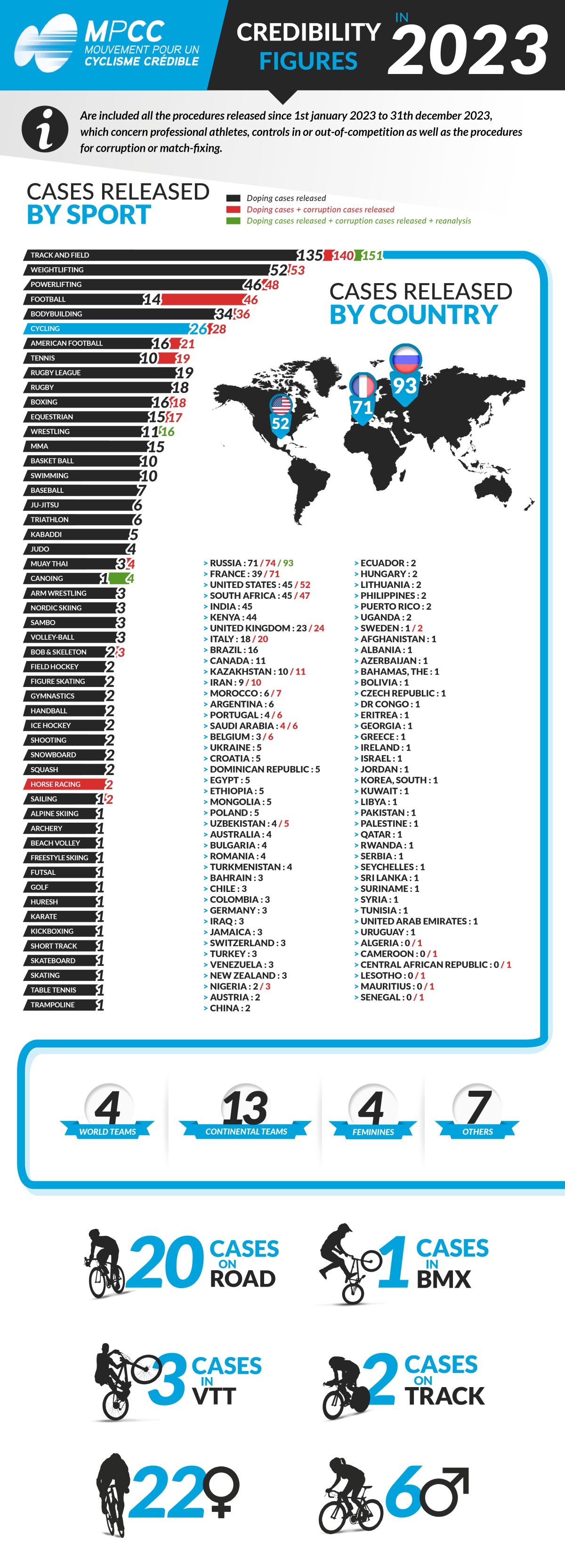With the 2023 review of the “Credibility Figures”, the MPCC takes note of the thirty or doping cases revealed in our sport. Despite this stable figure compared to 2022, our group reiterates that it is more legitimate than ever in the fight against doping.
Year 2023 closed its doors a few days ago with a clear observation : the number of doping cases revealed in high-performance sport, whether as a result of investigations by the police, journalists, anti-doping bodies independent from international federations or national anti-doping agencies, is on the rise. Last year, we recorded 620 cases of doping at the highest level of sport, compared to 587 in 2022, an increase of around 6%.
Some of these sports are affected by this increase : athletics, still at the top of the list, with 151 cases (compared to 133 in 2022) revealed by national agencies, the press or the AIU (Athletics Integrity Unit); or the MMA (15 compared with 12), violently shaken by scandals involving some of its stars (Usman Nurmagomedov, Conor McGregor) and in particular the end of collaboration between the USADA, the American anti-doping agency, and the UFC, the world’s biggest MMA league, effective from 1 January.
The plague of doping is also beginning to emerge in India, one of the countries most affected in 2023 and marked by surreal scenes of athletes avoiding urine tests, at the Delhi State Athletics Championships, last September.
Finally, the case of football (45 cases compared with 17) should be set into perspective, as we also note cases of sporting fraud. On 16 November, the French Professional Football League (LFP) published a list of dozens of players banned for several matches and fined for betting (prohibited by the French Sports Code) during the 2022-2023 season. The guilty players are mainly aspiring talents (aged 18 to 23) from Ligue 1, Ligue 2 and National 1, the top three professional levels of competition in french football.
A STABLE NUMBER OF CASES IN CYCLING
In this noixous climate for clean top-level sport, cycling had 28 cases of doping last year, a level more or less similar to the previous year (29 cases). However, 2023 was marked by four cases involving World Tour riders:
2 retro-active positive tests :
– Miguel Angel Lopez, who was tested weeks prior to the 2022 Giro d’Italia
– Robert Stannard, who was notified of an “anti-doping rule violation” by the UCI in June, but for a period dating back to the 2018 and 2019 seasons
And :
– Michel Hessman, suspended by his team after a positive test for a diuretic
– Alex Baudin, who was tested positive by the UCI for Tramadol in the last edition of the Giro d’Italia and disqualified from the race
It should also be noted that Tramadol has only been on the WADA list of banned products since 1 January 2024.
At our movement’s general meeting on 23 October, we rightly pointed out that the climate of suspicion surrounding our sport was still latent. The major teams that dominate the World Tour but are not members of our movement are once again invited to join us and play their part in the fight against doping. The MPCC remains open to all : riders, managers, support staff, riders’ representatives and fans of our sport. But it does require compliance with strict rules that are necessary if top-level cycling wants to remain credible. It is vital to play a part in the fight against doping, which is what we have done by carrying out regular cortisol tests; by pushing for a ban on Tramadol, which was added to the list of prohibited products by WADA on January 1; by promoting the work of the ITA (International Testing Agency), and so on.
Two-thirds of the men’s professional teams have placed their trust in the MPCC’s voluntary work, and we are also strongly encouraging those involved in women’s cycling to join us so that this new year can be marked by greater credibility with the general public, our supporters and our partners.

